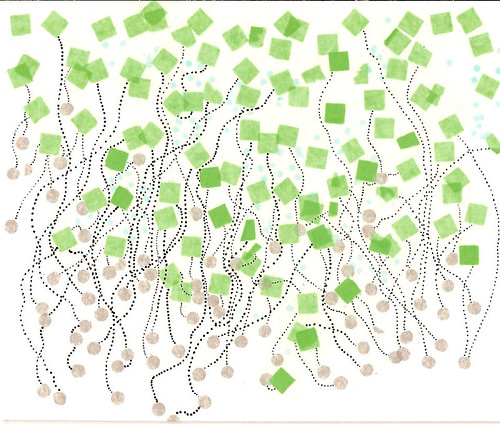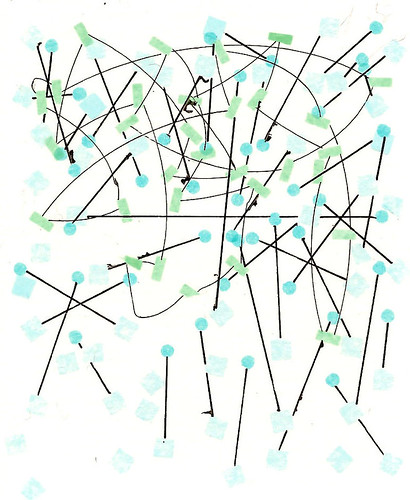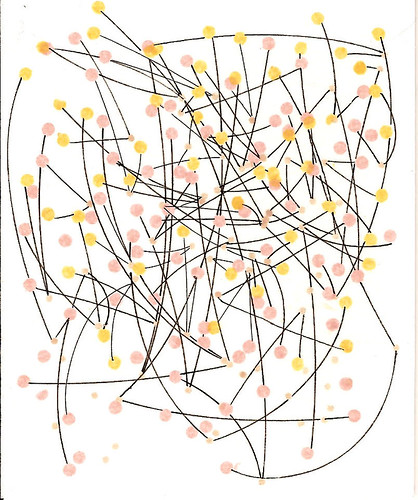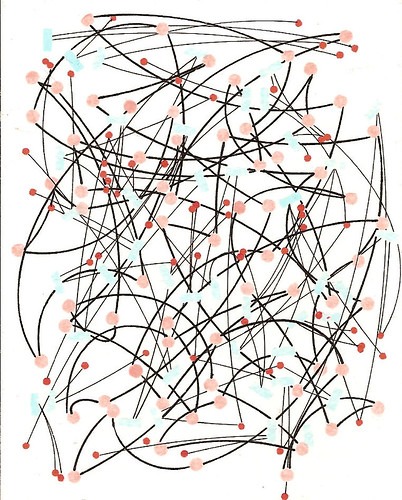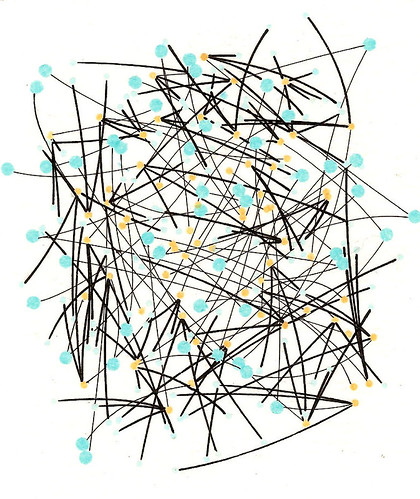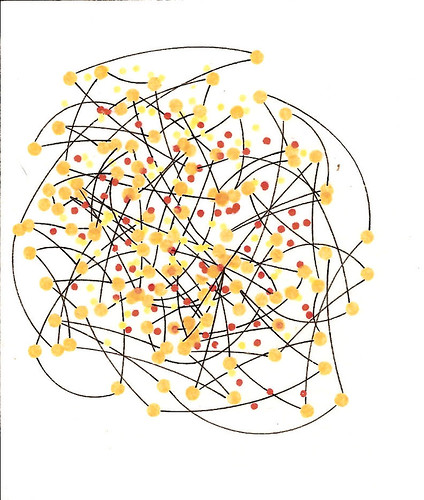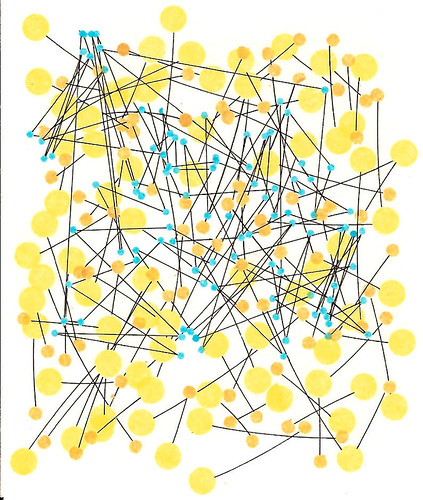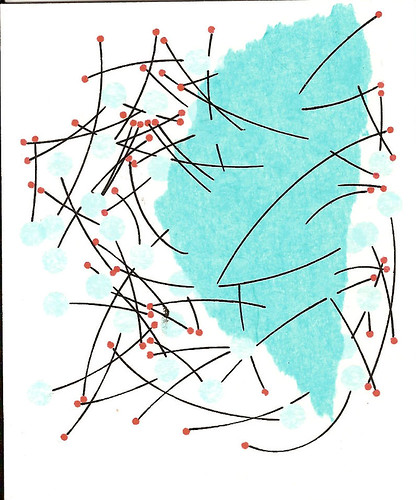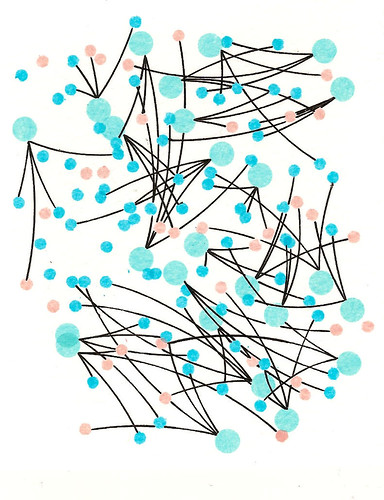"Emergence is the process by means of which a number of divergent elements are synthesized and organized into a new form. As a concept it has been particularly prominent in evolutionary theory. However, it is also widely deployed in symbolic interactionism, which also aims to capture the processual and adaptive nature of social life. In the writings of both George Herbert Mead and Herbert Blumer the interaction of body, mind, self, and society constantly leads to emergence. From this point of view, society itself is an emergent, as are all social objects.
...so can language be viewed in the same way? That is something that I am working on. Connecting to see if the dots point in this direction. I am conducting a dialogue with a fellow of great grasp of thought and ideas, which I will record and reproduce here to share any discoveries developed and discussed.
Been toiling away at the books lately. Will have images posted up to share soon!
Hope all is well,
D. White"
Sunday, July 15, 2007
Thursday, June 21, 2007
completed earlier
Wednesday, June 20, 2007
messages from thunderstorms




A late night communique from our Researcher in the Field:
"My apologies for the late hour. We had a lovely light-show of lightning and the noise that came with it. Fortunately, I kept myself late in the studio outpost and out of the downpour that accompanied such a light-show. During such time I finished a few more cutouts. It was an early-late hour, so I needed to rest my tired eyes for the night. Quickly wrote this entry and sent it to the Library before retiring for the sleep I can use.
D.White"
Monday, June 18, 2007
views into the future


" Hello,
Weather has finally turned out better, sunny skies and the mosquitoes are in full force. Due to the high humidity and subsequent air-conditioning that most homes have I have developed a nasal cold, so that has set me back from completing some of the cutouts that were assigned to my research post. I finished translating them to paper and completed the cutting of two of the forms, which leaves me with 24 remaining...
my cold is letting up a bit, so I must press on.
More to come!
D.White, Winnipeg. Canada"
*the colours for the images attached have been altered to preserve the research being done. images of the originals will be displayed once the project is complete. Researchers of L.L.S.S.
Sunday, June 3, 2007
Announcing our Winnipeg research post



The Library of Language Specimen Studies has completed the setting up of its newest research post in the closest-to-centre of North America (with the most population), Winnipeg, Manitoba, Canada.
It is an area with a lot of history, a humble fur-trading history with a varied storied past to explore. Two rivers meet near the centre of the city, called The Forks. At one point the founding of the nation of Canada was contested by the Red River (settlement) Rebellion in the mid-1800s. It is here that we have settle a young researcher, Mr. D. White. It is our hopes that he will continue to contribute from a micro/local perspective the observations that are relevant to the output of the Library of Language Specimen Studies.
Here is Mr. D. White's first posting:
June 2, 2007
This city’s been good to me while setting up the newest research outpost for the L.L.S.S. In fact, I ran into my brother (step-brother for those looking for factuality) whom I haven’t seen in 5-6 years. He looks well.
Been having some odd weather as of late, pretty much a whole week of rain and dark, cold skies. During the dreary weather, I received my memo from the L.L.S.S. to start work on completing 26 letterforms. I have scaled them up to fit the confines of the paper surface, it was instructed that they be paper cutouts. I suspect someone at the Library has a Matisse-side to them. I took some photos of the research post here in Winnipeg, it is located at the Cre8ery studio in the Exchange district of town. There was a very nice setting sun the other day that I had to photograph.
The photograph of myself is a bit humourous, I forgot to pack my camera’s tripod. So I had to make due by positioning my camera on top of the stereo which was playing some Sonny Rollins jazz while I was working. I was at the time lining up sketches to transfer onto the paper, Color-Aid paper. Hoping to have the transfer of sketches onto the paper completed and start the cutout process by the end of the week.
Fortunately, the weather is looking more like summer, sunnier skies and warmer weather. It is odd, that I find it more conducive to work in a window-less room on such days...
More to come.
D. White
*Our apologies to Mr.D. White for the misorientation for some of the photographs.
Tuesday, May 8, 2007
1000 words = image?
Thursday, April 26, 2007
neologism
"Back in 2000, the ADS (American Dialect Society) not only named the Word of the Year but chose also the Word of the Decade, the Word of the Century, and the Word of the Millenium. The Word of the Decade was the web, which beat among others the prefix e-, the combining form Franken-, ethnic cleansing, senior moment, and the slangy way "very" (as in way cool). The Word of the Century was jazz, an interesting choice, considering that it outmatched such weighty terms as DNA, media, melting pot, modern, and World War, though it certainly deserved to rout the other, rather lightweight nominees, cool, teenager, T-shirt, and teddy bear. The Word of the Millenium was the pronoun she, which did not exist before the year 1000 (it replaced heo, which was too often confused with he). A close runner-up was science."
p.223, The Life of Language
p.223, The Life of Language
Tuesday, April 17, 2007
early exercise in consideration
Monday, April 9, 2007
a little bit of a long while
We apologize for not posting anything in a week or two. Lots of goings-on as always but here is one of the specimens.
 ("untitled", April 2 2007, 10 inches square)
("untitled", April 2 2007, 10 inches square)
Looking through the archives of the library we re-discovered some specimen constellations drawn last year. We will post those later this week. Currently, there are many lines of research on the go sorry this post couldn't be longer.
Cheers!
 ("untitled", April 2 2007, 10 inches square)
("untitled", April 2 2007, 10 inches square)Looking through the archives of the library we re-discovered some specimen constellations drawn last year. We will post those later this week. Currently, there are many lines of research on the go sorry this post couldn't be longer.
Cheers!
Thursday, March 29, 2007
thing, dinc, ding, Ding, ting, causa, chose, cosa
A short history of 'thing':
The everyday word thing has a remarkable history that serves to illustrate the power of generalization. In Old English, thing meant "an assembly or meeting of people, such as a law court or parliament," a meaning shared by related Germanic words such as Dutch dinc, German ding (in modern German, Ding), and Norwegian, Danish, ans Swedish ting. After several centuries, the word's original meaning became narrowed down in all of these languages to "matter before an assembly or law court, lawsuit." This meaning, in turn, was gradually generalized to "any matter, any thing". Curiously, a similar development occurred in languages derived from Latin: The Latin word causa "legal matter, case, cause" was generalized in French chose and Italian and Spanish cosa to mean "matter, thing".

The everyday word thing has a remarkable history that serves to illustrate the power of generalization. In Old English, thing meant "an assembly or meeting of people, such as a law court or parliament," a meaning shared by related Germanic words such as Dutch dinc, German ding (in modern German, Ding), and Norwegian, Danish, ans Swedish ting. After several centuries, the word's original meaning became narrowed down in all of these languages to "matter before an assembly or law court, lawsuit." This meaning, in turn, was gradually generalized to "any matter, any thing". Curiously, a similar development occurred in languages derived from Latin: The Latin word causa "legal matter, case, cause" was generalized in French chose and Italian and Spanish cosa to mean "matter, thing".

Thursday, March 22, 2007
How the Alphabet was made
The following is a paraphrases quotation from Rudyard Kipling's 'How The Alphabet Was Made':
In this somewhat far-fetched way, a whole alphabet is created by Taffimai
Oh, we also have not yet revealed the Library of Language Specimen Studies' coat of arms (we are trying to make it a page element but are having some interesting times trying to place it within the layout)

*edit note: "Oh! fixed it!! Hooray!"
Taffimai designs what she calls 'noise-pictures'. The letter 'A' is a picture of a carp with its mouth open; this, Taffy tells her father, looks like his open mouth when he utters the sound ah. The letter 'O' matches the egg-or-stone shape and resembles her father's mouth saying oh. The letter 'S' represents a snake, and stands for the hissing sound of the snake.
In this somewhat far-fetched way, a whole alphabet is created by Taffimai
Oh, we also have not yet revealed the Library of Language Specimen Studies' coat of arms (we are trying to make it a page element but are having some interesting times trying to place it within the layout)

*edit note: "Oh! fixed it!! Hooray!"
Wednesday, March 21, 2007
constellation

"Etymologically, 'consider' is a metaphor meaning "take the stars into account" (from Latin 'sider'-, sidus, "constellation")
* note: meaning can be defended as the sum of the responses to a word or phrase; words and phrases may be regarded as responses to stimuli. After a word has been associated for a long time with the stimulus that provokes it, the word itself picks up aspects of the response elicited by the stimulus.
Thursday, March 15, 2007
gift from a dear friend
meaning of words according to Humpty Dumpty

"When I use a word," Humpty Dumpty said in a rather a scornful tone,"it means just what I choose it to mean --- neither more nor less."
"The question is," said Alice,"whether you can make words mean so many different things."
"The question is," said Humpty Dumpty, "which is to be master--- that's all."
Through the Looking Glass - Lewis Carroll
Sunday, March 11, 2007
assessment of the field

Here is one sample for us to share, although not final, this is a part of the process.(as referenced on February 13th, 2007 entry)
Hello.
Sorry we haven't written an entry in a little bit of a long while. We are currently collecting samples of writing from dear friends and well-wishers begun processing some of the returned samples. Some of the samples are international for that we are very excited to be working on them.
Saturday, March 3, 2007
okay
We found this in a book recently reviewed by some of our researchers.
"A vogue to create abbreviations broke out in the United States in the late 1830s. How this became fashionable, somewhat like slang, was studied and described in 1963-64 by the scholar Allen Walker Read in a series of articles in the journal 'Amercian Speech'. His greatest discovery was the origin of O.K., which started out as a jocular abbreviation, but became over time a nearly universal affirmative, used in many languages throughout the world. Professor Read traced the usage to the city of Boston, where in the late 1830s it became faddish to abbreviate certain common phrases, such as 'no go' or 'no good', which were rendered 'N.G.' and 'Our Men First' (meaning 'original settlers'), which was abbreviated O.F.M. The fad took a humourous turn when jocular misspellings of common phrases began to be abbreviated, leading to such forms as O.W. for 'oll wright' ("all wright"), K.Y. for 'know yuse' ("no use"), and O.K. for 'oll korrect' ("all correct"). While the other abbreviations vanished, O.K. achieved national currency in the name of the Democratic Party's "O.K. Club". This club was formed in New York City in 1840 to promote the reelection of President Martin Van Buren, and although the "O.K." in the club's name was actually an abbreviation of 'old kinderhook', a nickname of Van Buren's, whose birthplace was the village of Kinderhook, near Albany, N.Y., the abbreviation became firmly established in the sense of "all right" that is used today.
Postscript: 120 years later, in 1961, a group of astronauts on the Mercury Project popularized a fresh and more intensive variant of O.K. It was A-OK, meaning "excellent, perfect," and it was coined by blending a century-old adjective, A-one or A1, meaning "first class" with the equally old O.K. In effect, two old abbreviations were combined to create a new one. "
-"The Life of Language", p. 39
"A vogue to create abbreviations broke out in the United States in the late 1830s. How this became fashionable, somewhat like slang, was studied and described in 1963-64 by the scholar Allen Walker Read in a series of articles in the journal 'Amercian Speech'. His greatest discovery was the origin of O.K., which started out as a jocular abbreviation, but became over time a nearly universal affirmative, used in many languages throughout the world. Professor Read traced the usage to the city of Boston, where in the late 1830s it became faddish to abbreviate certain common phrases, such as 'no go' or 'no good', which were rendered 'N.G.' and 'Our Men First' (meaning 'original settlers'), which was abbreviated O.F.M. The fad took a humourous turn when jocular misspellings of common phrases began to be abbreviated, leading to such forms as O.W. for 'oll wright' ("all wright"), K.Y. for 'know yuse' ("no use"), and O.K. for 'oll korrect' ("all correct"). While the other abbreviations vanished, O.K. achieved national currency in the name of the Democratic Party's "O.K. Club". This club was formed in New York City in 1840 to promote the reelection of President Martin Van Buren, and although the "O.K." in the club's name was actually an abbreviation of 'old kinderhook', a nickname of Van Buren's, whose birthplace was the village of Kinderhook, near Albany, N.Y., the abbreviation became firmly established in the sense of "all right" that is used today.
Postscript: 120 years later, in 1961, a group of astronauts on the Mercury Project popularized a fresh and more intensive variant of O.K. It was A-OK, meaning "excellent, perfect," and it was coined by blending a century-old adjective, A-one or A1, meaning "first class" with the equally old O.K. In effect, two old abbreviations were combined to create a new one. "
-"The Life of Language", p. 39
Wednesday, February 28, 2007
dots and points; recent specimens


“[...] a description is an objective depiction and a depiction is a subjective description. Interesting idea, hard to illustrate.” A quote from the blog of Paul Pope (pulphope.blogspot.com). We looked at this sentence with great care. In it we found something similar to our recent inquiry of research. At first we thought these examples were constellations mapped out, having read Mr. Pope’s thoughtful paraphrased sentence, we looked at the examples again and found more to it than that. We now believe these examples to be that of dots and points.
1. A spatial point is a concept used to define an exact location in space. It has no volume, area or length. Points are used in the basic language of geometry, physics, vector graphics (both 2d and 3d), and many other fields. In mathematics generally, particularly in topology, any form of space is considered as made up of points as basic elements.
2. A point in Euclidean geometry has no size, orientation, or any other feature except position. Euclid's axioms or postulates assert in some cases that points exist: for example, they assert that if two lines on a plane are not parallel, there is exactly one point that lies on both of them. Euclid sometimes implicitly assumed facts that did not follow from the axioms (for example about the ordering of points on lines, and occasionally about the existence of points distinct from a finite list of points).
3. Therefore the traditional axiomatization of point was not entirely complete and definitive.
4.When used as a diacritic mark, the term dot is usually reserved for the Interpunct ( · ), or to the glyphs 'combining dot above' and 'combining dot below' which may be combined with some letters of the extended Latin alphabets in use in Central European languages and Vietnamese.
5. In mathematics and physics the dot denotes the time derivative.
Sunday, February 25, 2007
recent specimen

The preceeding is one of the specimens that have been at the forefront of our research. This specimen in particular is in the personal possession and collection of Mrs. S. McConnell. Our preliminary decipherment of the specimen, word-form, connotes the same general meaning as the word “toilet”. Obviously, words have a certain appeal for some people. Even a toilet can be beautiful.

Edit note:
Top: toilet, 8 in. by 8 in., mixed media with pen & ink, December 2006
Bottom: fountain, Marcel Duchamp, 1917
Thursday, February 15, 2007
An area of research
Tuesday, February 13, 2007
commentum est veritas

We are currently awaiting the reply from some of the participants of a project that is going to take approximately 10 years to complete. It deals with the tracking and monitoring of participants signature over the course of this time period but it also monitors their location over the time period as well.
26 are involved and we eagerly await the results of our collective (those of initiator and those of the participants) efforts.
There are also plans in the works for some of our researchers to head out the Eastern part of the country known as Canada. The purpose of this is very much of close concern but we will certainly have photos available once the voyage is confirmed.
Monday, February 12, 2007
Onwards on the meaning

The basis of the primary focus of the Library of Language Specimen Studies’ research is in language. Fairly simple, no?
After much research there is really nothing simple at all about language. There are many facets to what language is. It has the use of mediating meaning through communication, plus there are ground rules to that mediation. An example would be, misunderstandings in a dialogue. One participant, for simplicity we will call him/her Y, is conversing with the other participant in this example we will refer to him/her Z. At some point during their conversation (in this example they are using the same language, same regional dialect, same level of education, same age, similar life experiences, same mental faculties... pretty much copies of one another) there is a meaning or idea that needs to be conveyed. Y would like to describe an apple she/he ate. Z is not familiar with this fruit (hence, only similar life experiences). Y goes about describing the round form of the fruit, if this particular apple had a stem on top or not, the sweetness of it, the texture of it. A peculiar thing is going on in Z’s mind. The description of the features of the apple from Y are being processed by comparison method. The description of the form is being compared to, say, a globe or spheric ball. The sweetness of the flavour of an apple is being compared to say a watermelon. This is where language has its obvious oddities... It is easy to describe what it is and what it isn’t, eventually anything can mean everything.
We find these types of phenomena fascinating. In forthcoming entries, we hope to add some of our current areas of research.
*The Phaistos disc. 1850-1600 BCE. Discovered in Crete in 1908. Currently remains undeciphered
Thursday, February 8, 2007
What this is about?

At this present time it is quite difficult to quantify what the Library is all about. From the title of this prospective website, it is quite easy to understand what the Library deals with... but what does it, the Library, do?
The purpose is that of gathering knowledgeable examples of Language. Heck, we don't understand it most of the time ourselves.
We hope that in future posts about our progress on current samples that the reasoning becomes clearer. Until then, please take care.
Subscribe to:
Posts (Atom)










